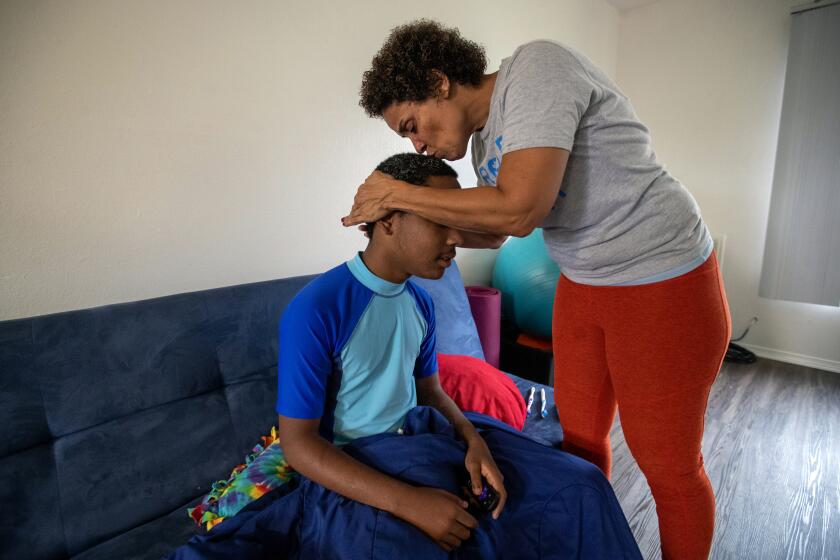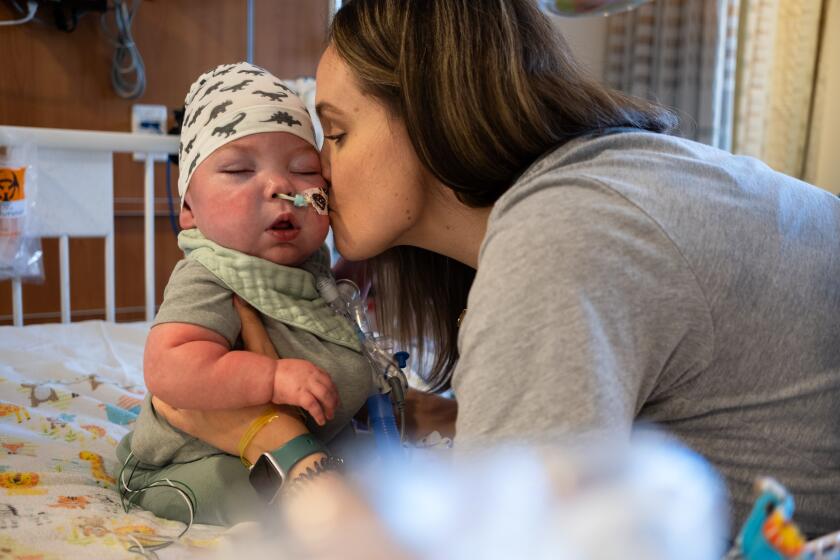How homes for quadriplegics lost out on a raise after Californians passed Prop. 35

- Share via
- Congregate living health facilities, which assist quadriplegics and others with serious medical needs, say they have relied on the same level of payments from the state for decades.
- California was slated to give them a raise in January, but the passage of Prop. 35 unraveled that plan. Backers of the ballot measure said state lawmakers still have flexibility to choose to fund such programs.
- Operators of the facilities say that without more funding, their future is at risk.
Luis Cervantes chose to move home after recovering from a car accident that made him a quadriplegic.
But the 29-year-old found it uncomfortable to ask his mother and sister to help him with physical needs. He stopped going with them on outings from their Sylmar home because it was too much work. Cervantes ended up grappling with suicidal thoughts and landed in the hospital again, suffering a urinary tract infection.

He decided against returning home, but was dissatisfied during his months at a nursing facility. By then, he had heard about Laramie House, a little-known kind of home called a congregate living health facility.
The six-bed site in Chatsworth provides day-to-day medical care to assist mentally alert people who rely on ventilators, are quadriplegic or have other kinds of serious needs, but in a small setting that feels like a suburban home.
“I’ve been fighting to get into this place since I found out about it,” said Cervantes, who moved in this fall.
Luigi Mangione, the 26-year-old charged with murdering UnitedHealthcare CEO Brian Thompson, struggled with spondylolisthesis before receiving surgery.
Such facilities were born decades ago in the San Fernando Valley, the brainchild of a nurse tending to quadriplegic patients. And for decades, their operators say they have relied on the same level of payments from the state — a situation that they say clouds their future.
“We haven’t had a raise in 40 years,” said Sian Welch, chief executive and administrator of New Start CLHFs Independent Training Centers, which operates three facilities including Laramie House.
If that continues, she said, “we’ll have to close our doors.”

California had been planning to raise reimbursement rates for facilities like Laramie House starting in January, but they were on the losing end after voters approved Proposition 35 in November.
The ballot measure aimed to secure funding for Medi-Cal, the California Medicaid program, by making an existing tax on managed care organizations permanent.
It was backed by a muscular coalition of healthcare groups including the California Hospital Assn. and Planned Parenthood Affiliates of California. The ballot measure also outlined a spending plan for the money, including increased payments for many healthcare providers who see Medi-Cal patients.
Suicide prevention and crisis counseling resources
If you or someone you know is struggling with suicidal thoughts, seek help from a professional and call 9-8-8. The United States’ first nationwide three-digit mental health crisis hotline 988 will connect callers with trained mental health counselors. Text “HOME” to 741741 in the U.S. and Canada to reach the Crisis Text Line.
Doing so, proponents said, would help patients by easing shortages of healthcare providers who accept Medi-Cal. But because state lawmakers had already made budget plans for that tax revenue, passing Proposition 35 unraveled other plans for the tax money that weren’t listed under the ballot measure.
State Sen. Caroline Menjivar (D-Panorama City) said she warned colleagues that worthwhile investments would be nullified if it passed. For many people with complex needs, she said, facilities like Laramie House “are the last line of defense.”
More than 250 such facilities are licensed across California, over half of them in Los Angeles County, according to the most recent available state data. Mariam Voskanyan, president of the Congregate Living Health Facility Assn., said fewer may now be operating, based on her efforts to reach them.

Such facilities haven’t received an increase in their Medi-Cal reimbursement rate since they originated in the 1980s, according to the Congregate Living Health Facility Assn., an industry group. The Department of Health Care Services said that based on available documentation, reimbursement rates for the facilities had not changed since at least 2012.
Daily rates for these homes range from under $92 to roughly $490 depending on the level of care required, compared with $292 to $610 daily for skilled nursing facilities, according to a September brief from the Department of Health Care Services.
Yet such homes are supposed to provide a level of medical care even more intense than that in nursing facilities. Before Proposition 35 passed, lawmakers agreed to a rate increase starting in 2025 to bring them closer in line with nursing homes, boosting most rates by roughly 60%. The total cost was $16 million annually, half of it from federal funds, according to the Department of Health Care Services.
Proposition 35 backers say state lawmakers could still choose to increase funding for the facilities by allocating money from the state general fund, where some of the tax revenue is going. Representatives of the homes were frustrated, however, at having to start over lobbying for the money.
Only 15% of phone calls seeking psychiatric appointments for Medicaid patients resulted in an appointment in Los Angeles, the lowest percentage out of four cities in a “secret shopper” audit, researchers found.
And as President-elect Donald Trump heads toward his second term, health experts anticipate the federal government could make significant cuts to Medicaid, leaving programs competing for fewer Medi-Cal dollars.
“We are going to have an environment that potentially puts the Medicaid program at great risk overall,” said Mayra Alvarez, president of the Children’s Partnership, one of the groups that opposed Proposition 35.
Congregate living health facilities were born out of the efforts of Mary Williams, a Northridge nurse who was frustrated with the choices available for her quadriplegic patients when they were ready to leave the hospital.
Williams started opening residential facilities in the San Fernando Valley to care for patients in the 1980s, at times tangling with Medi-Cal officials who raised concerns about regulatory requirements. When government workers stepped in at one point to remove residents from the homes, one parked his wheelchair in a Northridge driveway in protest, telling The Times, “I feel safe here. And I’m not moving.”

Regulations to govern the homes had not yet been drafted in Sacramento, The Times reported at the time, although Welch said Mary Williams — her mother — had been working with Medi-Cal from the beginning.
Today, “we are licensed by the California Department of Public Health, but they look like residential homes and they feel like residential homes,” said Irene Tokar, a Congregate Living Health Facility Assn. board member. Residents “can go to church, they can go to the movies, they can go to lunch, be visited by family.”
Cervantes said less than a week after moving into Laramie House, he had joined a housemate on a bus ride to the mall. “The fact that I know that I have the freedom to go out if I want — that changes my mood a lot.”
Tyler Smith, 42, spent weeks in a coma after getting West Nile virus. He is now a quadriplegic and relies on a ventilator. Being in the hospital was “a special kind of hell” where his twin boys couldn’t visit him, he said.
An autistic child. The struggle for services. The 911 calls. This is the harrowing story of how one mom scrambled to get help for her son and keep her head above water.
At Laramie House, his days include physical therapy, visits from family and friends, and meetings with his Bible study group. Technology helps him dictate text and continue working as a consultant. He can now breathe on his own for up to six hours, and his goal is to stay at Laramie House “until I can get as well as I’m going to get.”
“It would be awful if suddenly this place had to shut down,” he said.


Welch said she has gone into debt as costs for nurses have skyrocketed. The homes have to meet state requirements for staffing, including a nurse and a certified nurse assistant; Welch said she also pays for a restorative nurse assistant to help residents regain the ability to move and stand.
If “you have to just cut everything,” Welch said, “it won’t be what it’s supposed to be.”
If state rates do not increase, more homes will close and residents will be displaced, Voskanyan said. Most are freestanding, she added, “and don’t have other lines of income to keep us afloat.”
Her association spent $130,000 on lobbying during the last California legislative session on a handful of bills, including one from Menjivar that would have required a study on the costs of running such facilities.
Families can get Medicaid benefits for services that allow people to live at home, instead of in a medical facility, but thousands of Californians are now on the waitlist.
The homes have also been tangled in another state problem: Residents like Cervantes can access congregate facilities through a waiver that allows Californians to get Medicaid benefits for in-home care, but demand has outstripped spots, resulting in a lengthy wait list.
For instance, Welch said a health plan turned down Angel Bustos when he first sought to move in, which forced him to wait more than a year for the waiver instead. Bustos, who was paralyzed for nearly a year after surviving gunshots, said he had suffered indignities at nursing homes, including a grisly bedsore on his back.

“I felt like I was cattle.”
At Laramie House, the 37-year-old celebrated his wedding in its backyard. He made a trip in his wheelchair to the Starbucks down the street. He stood up for the first time in years.
“You feel like you’re getting ready to go home,” Bustos said. “Or you feel like you’re at a home — which you are.”
Times staff writer Melody Petersen and researcher Scott Wilson contributed to this report.
More to Read
Sign up for Essential California
The most important California stories and recommendations in your inbox every morning.
You may occasionally receive promotional content from the Los Angeles Times.














